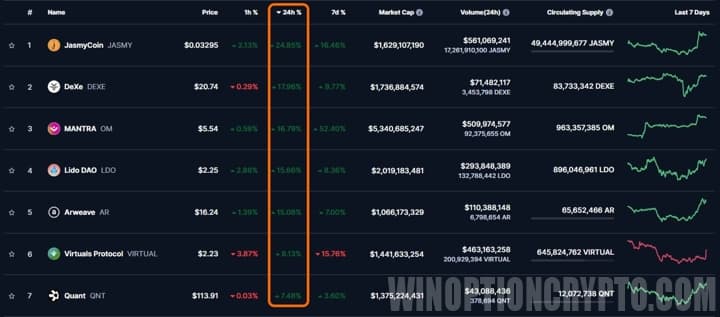Cryptocurrencies provided by TradingView
Cryptocurrency Dynamics
Active traders and investors need up-to-date information on cryptocurrency dynamics. This data allows them to assess investment performance in terms of profitability and analyze the market to identify promising assets.
A thorough market analysis allows traders to identify optimal entry and exit points. With this approach, traders can choose the right moment to secure profits.
A long-term investor may purchase cryptocurrency even at high price levels, focusing on the potential for significant growth. However, this strategy is not suitable for active traders. A more rational approach involves buying after a correction, as the reduced price of the asset creates opportunities to profit.
Cryptocurrency dynamics analysis relies on two key parameters: market capitalization and price movement. These indicators are essential for Bitcoin and all digital assets. Let's examine each one.

Capitalization
The market capitalization of a cryptocurrency reflects the total value of all coins of a particular digital asset in circulation. In other words, it indicates the market significance of a specific cryptocurrency. You can estimate it by multiplying the price of a single coin by the total number of coins in circulation.
Suppose you need to assess the scale of a cryptocurrency project. In that case, we recommend comparing its market capitalization with alternative coins. Generally, digital assets with a large market capitalization are more stable, but their growth potential might be lower. There is an exception to this rule – Bitcoin. However, this trend is noticeable overall: coins with large market capitalization do not increase in price as quickly as their lighter competitors.
By analyzing the change in the market capitalization of leading crypto projects over time, you will learn to understand trends in the cryptocurrency market. The key thing to remember is that a high value of this indicator does not guarantee the asset's price will rise. Still, you should monitor it as it plays a significant role in deciding whether to invest in specific projects.
Total Capitalization
The total cryptocurrency market capitalization as of January 2018 was $762.5 billion, of which bitcoin accounted for $259 billion. However, high volatility characterizes these figures. There are known cases when the capitalization of cryptocurrencies decreased by $3 billion in just one minute. Such sharp fluctuations happen when traders mass-sell assets due to unmet market expectations.
Such a sharp price decline usually reaches a strong support level, from which quotes partially recover. Professional investors stabilize the situation by actively buying up undervalued coins.
Let's consider a situation:
- The price of a coin drops from $100 to $90.
- The trader sells it.
- The price continues to fall.
- The experienced investor realizes the drop is unjustified and begins buying the asset at a favorable price.
The tactic described above, where investors purchase undervalued assets, is the strategy of working in a bear market.
By the end of 2017, Ripple took second place in capitalization, surpassing Ethereum and approaching Bitcoin. However, by the following year, the situation changed: Ethereum showed growth, reaching a price of $1,100, which allowed it to regain its previous capitalization level.

Market Price
In 2017, the cryptocurrencies NEM and Ripple showed the highest growth. The value of NEM increased by 28,000%, while Ripple's surged by more than 33,000%. The first cryptocurrency also showed growth. By the end of 2017, the price of BTC reached $15,000, gaining over 1300% during the year.
We expect further price increases for coins with limited supply in the future. However, another point to consider is the intrinsic value of cryptocurrencies. Traders often underestimate this value, although value investments have already proven their effectiveness over the long haul on the stock market.
Intrinsic Value
Over time, trading becomes saturated with speculative cryptocurrencies – that's the trend. Digital coins, issued by exchanges to increase their capital, appear on the market. You can profit quickly, but long-term investments in such coins are unwise. They are speculative instruments, nothing more.
Digital currencies should possess intrinsic value. While Bitcoin became a symbol of the new industry, ensuring its value, the situation with other coins is more complex. Long-term investment success cannot rely solely on marketing. It requires more – technologies and ideas, which a particular cryptocurrency can help realize.
Assessing coins other than Bitcoin shows that, for instance, Ethereum represents smart contracts, while Ripple facilitates transactions between banks. From this, we can only guarantee long-term prospects by altcoins offering more than capital and emission.



To leave a comment, you must register or log in to your account.